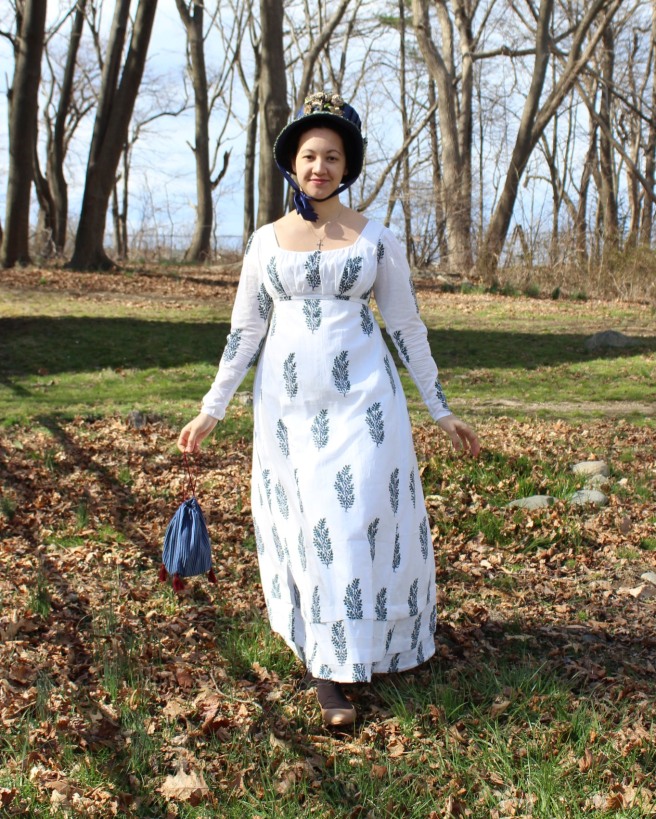Textiles and the natural world are inextricably linked. Until very recently, all textiles were made from flora (linen, raime, hemp) or fauna (wool, silk, fur), and dyed with flora and fauna. Flora and fauna also influenced the decoration of textiles, from Elizabethan floral embroidery, to Regency beetle-wing dresses, to Edwardian bird-trimmed hats. Celebrate the natural world (hopefully without killing any birds) with a flora and/or fauna inspired garment.
This is the description of the HSF Challenge #9: Flora and Fauna. I’m super excited about my garment: the all new 1815 Tree Gown I recently showed a sneak peak of as well as photos of in action during archery and outdoor lounging! The archery and outdoor lounging, in particular, include great pictures of the dress, so if you haven’t seen them yet, you really should go check them out!

I love love love this dress! It’s super comfy and super cute. You might remember that I don’t own many printed or patterned clothes (modern or historic), but I branched out (haha, unintentional bad pun) with this one and I love the results! There’s something so refreshing about the classic white Regency dress that has been shaken up a bit with a bold print. Also, from the HSF perspective, it is made from cotton and printed with a flora inspired motifs! Double duty challenge fulfillment right there.

There are pictures of the interior construction of this dress in this previous post. To summarize, the dress is machine sewn on the inside seams and hand finished. Most of the interior seams are french seams. The dress closes at the back with hooks at the waist and a drawstring at the back neck. The front neck has a drawstring as well.
More facts:
Fabric: almost 5 yds of hand block printed sheer cotton (made in India and sold on eBay via Heritage Trading).
Pattern: loosely based on my other Regency gown patterns for my basic measurements, but adapted to resemble my main inspiration dress at the Met.
Year: 1815.
Notions: two hooks, about 1 yd of 1/4″ cotton twill tape, thread.
How historically accurate?: I give it 95% rating. Really, the only thing keeping it from “as accurate as can be with modern materials” is that it is machine stitched on the inside seams. It is hand printed fabric, sewn in historic ways, and hand finished.
Hours to complete: 16? Total? That’s not bad for me!
First worn: Regency Dance Weekend, mid-April 2013.
Total cost: $25 for the fabric (it’s almost doubled in price since I bought mine!), maybe another $1 for the notions?
Now for inspiration. The dress is most closely based off of this dress at the Met. I changed some things, but I think the resemblance is quite clear.



These two dresses were other more minor inspiration for the Tree Gown: 1812 yellow silk wedding dress and early 19th century slip, mostly for their square necks and back tie closures.
Eee! All I can say in conclusion is how much I love my Tree Gown!!!


This is beautiful! You’ve nailed the silhouette, the fabric is lovely, and the fit is spot on.
Those are such wonderful comments! (The sort that every costumer wants to hear!) Thank you!
It’s GORGEOUS!
Yay! Thanks!
Quite perfect, as always 🙂 And I love love love the fabric!
Incredible. It is fun to see you in the dress. I am really glad I had a chance to see the dress when I was there with you a week ago. It is a beautiful gown.
Love,
Aunt Doris
You look just like you stepped out of a Regency fashion plate!
So much love for this, really beautifully done.
Ohhhh, I’ve missed so many amazing garments lately! This dress is beautiful and you look so very period in it!!! The hat matches perfectly 🙂
Lovely dress! I’ve seen back-drawstring-closure dress on someone else before, and I was horrified because it gaped horribly in between the back top and bottom closures. Perhaps it all comes down to good fitting, but your gown doesn’t appear to gape at all. Do you have any tips on how to make a good back closure?
That is a true problem with tie back dresses. I think the difference here is that the top neck edge is actually wider than the finished distance needs to be while I’m wearing it. That means that the drawstring actually does gather fabric in addition to closing center back. You can see the gathered fabric on the inspiration dress as well as on the Tree Gown, if you look closely.
Here’s an example of a tie back gown I made that has the gaping problem because I cut the back pieces differently than this Tree Gown. The thing is, this example will always be worn under another dress, so the top dress keeps the gap from showing. 😉
https://quinnmburgess.wordpress.com/2013/03/09/hsf-5-mprsw-1-blue-under-dress/
Gorgeous job, Quinn!
The more I look at this dress, the more I want it. Okay, my own light and airy print dress. It does look so incredibly comfortable. I have such a tendency to buy plaids, I lack prints other than the lovely sprigged print gifted to me and the red/brown/gold print from my husband.
It’s hard to break your normal pattern of things! I’ve had to make a conscious effort to buy printed fabric instead of only solids. I’m sure you can work on your plaid habit, too! 🙂
It’s so beautiful! I love the spencer too from the archery pictures.
Thank you! 🙂